World-Class Inequality
One of the persistent issues of the 2016 U.S. Presidential campaign was the wide (and growing) divide between the “haves” and the “have-nots”—variously expressed as a rising sentiment against the “one-percenters,” or as laments against the “hollowing out of the middle class.”
Is the U.S. any more unequal than other countries? A report from the Organization for Economic Co-operation and Development (OECD) suggests that it is. Looking at all developed nations, OECD researchers found that the average “score” of inequality, from 0-1, was right around 0.318, with higher scores indicating a bigger gap between the wealthiest citizens and the average working person. (A “0” score would indicate that everybody enjoys exactly the same income, while a “1” score would mean that one person took home all the income.) America, home to Wall Street and its multi-million-dollar bonuses, came in with the third-highest income inequality, behind only Chile and Mexico, and far more unequal than the world’s most egalitarian societies in Scandinavia: Iceland, Norway, Denmark and Finland. (Turkey came in at a virtual tie with the U.S.)
What does that mean? Traditionally, societies with greater inequality tend to be less socially stable, to the point where international economists monitor the discrepancy between rich and average citizens to determine which nations are in danger of experiencing a revolution among the masses. Consider the most recent election a form of revolution, which may have failed, considering the number of Wall Streeters and wealthy corporate titans who are taking office in president (intentional) Trump’s cabinet.
Source:
http://www.oecd.org/social/OECD2016-Income-Inequality-Update.pdf


